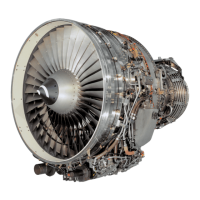EFFECTIVITY
ALL CFM56 ENGINES
CFMI PROPRIETARY INFORMATION
CFM56-ALL TRAINING MANUAL
REQUIREMENTS
BORESCOPE INSPECTION
Page 54
Sep 03
DOCUMENTATION
(ALL) :
NDTM.
Words such as nicks, dents and scratches, for example,
are often used in the AMM.
The NDTM (Non Destructive Test Manual) provides a
comprehensive list and an explanation of these words in
its Introduction section.
It also provides sample forms on which to record the
defects encountered, which include record forms and
maps for each rotor stage.
Recording of defects.
It is highly recommended that a record be maintained for
each borescope inspection conducted.
The maps are provided so that any damage within
serviceable limits can be recorded pictorially by blade
number and position on the blade.
Propagation of the damage can then be pictorially
illustrated during subsequent inspections. The rotor blade
maps are oriented about the zero reference for inspection
continuity.
The records and maps will remain in the engine folder
until the damaged parts are repaired, or replaced.
Note : When defect/damage maps are used, accomplish
the mapping at the inspection site. Do not rely on memory
of the defect in order to carry out the mapping in an ofce
after the inspection.
Photo recording.
Whenever photos are made of a defect, a record of the
photo should be made immediately.
If the photo is not recorded relative to the engine
serial number, stage, port, direction of view and date,
correlation of the hardware damage and the photo will be
extremely difcult.
Refer to the NDTM for more information.

